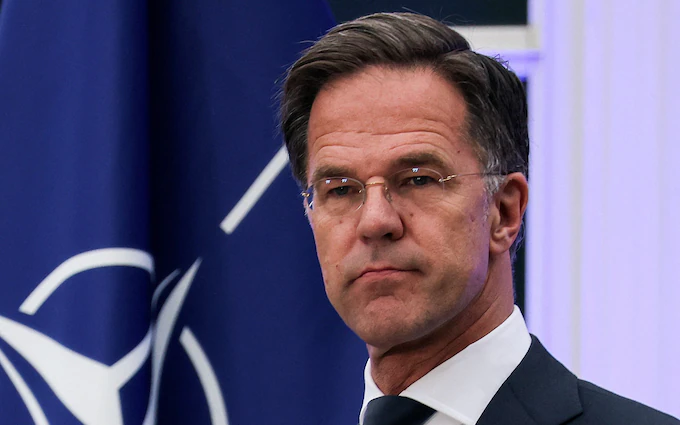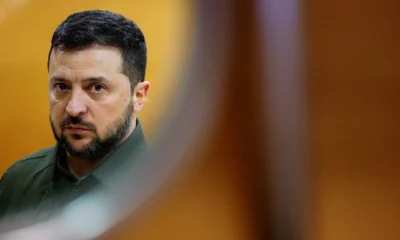Published
10 months agoon

In a rather stern warning that reverberates across the Western military alliance, NATO Secretary General Mark Rutte has urged member nations to adopt a “wartime mindset” to counter the escalating threat posed by Russia.
Speaking at a crucial moment in global security, Rutte painted a grim picture of the years ahead, cautioning that NATO members are ill-prepared for the long-term confrontation Russia is gearing up for.
“We are not ready for what is coming our way in four to five years,” Rutte declared in his first major speech since assuming office in October. His message: NATO nations must significantly increase their defense spending now or risk paying a far steeper price later.
Its Time…
Rutte’s speech comes as NATO struggles with uneven defense contributions among its 32 members. While the alliance’s agreed target is for members to spend 2% of their GDP on defense, not all have met this benchmark.
In contrast, Russia is aggressively ramping up its military expenditure, with projections indicating that by 2025, defense spending will constitute a third of its state budget—the highest level since the Cold War.
The Secretary General emphasized the urgency of action, stating, “If we don’t spend more together now to prevent war, we will pay a much, much, much higher price later to fight it.”
Rutte’s remarks also spoke of the realities of Russia’s military campaign in Ukraine. By November, Russian forces had seized six times as much Ukrainian territory in 2024 compared to the previous year, showcasing Moscow’s relentless pursuit of its geopolitical goals.
Trump’s Influence on NATO Spending
Rutte’s tenure coincides with the potential return of Donald Trump to the White House, a development that could reshape NATO dynamics.
During his first term, Trump famously pressured NATO members to increase their defense budgets, even threatening to withdraw the United States from the alliance if they failed to comply. This tough-love approach, Rutte acknowledged, had a positive impact.
“Donald Trump was completely right when in his first term he forced us to spend more,” Rutte said. “We are considerably spending more than before he became president.”
Known as “The Trump Whisperer,” Rutte played a key role in tempering Trump’s frustration with NATO, assuring him that European nations were indeed stepping up their defense investments. Now, as Trump eyes a return to power, Rutte is once again employing flattery and diplomacy to ensure continued U.S. commitment to NATO.
A Plea to the People
While addressing NATO’s leaders, Rutte also made a direct appeal to citizens across member nations, urging them to prioritize defense spending despite competing domestic concerns such as rising living costs, healthcare, and migration.
“I’m really pleading directly to the one billion people living in NATO territory, and particularly in Canada and Europe,” Rutte said. “Call up your politicians, tell them that you agree that yes, it is difficult, it will mean somewhat less spending on some other items, but that you want them to prioritize defense.”
Rutte’s plea is rooted in a broader concern for preserving the democratic values and way of life that NATO was established to protect. “If you have children, grandchildren, if you think our way of life should be preserved, then we have to prioritize defense,” he urged.
Vladimir Putin Boasts New Horror Weapon ‘Will Make Nukes Virtually Redundant’
Meanwhile, Vladimir Putin has revealed what he claims is a revolutionary missile that could render nuclear weapons obsolete. The Russian president’s statements, sourced from a Kremlin transcript, center around the nuclear-capable Oreshnik missile, which he asserts is immune to missile defense systems due to its extraordinary speed.
Putin stated, “What we need now is not to improve the nuclear doctrine, but the ‘Oreshnik,’ because enough of these modern weapons systems puts us on the verge of virtually eliminating the need to employ nuclear weapons.”
Oreshnik. A Weapon of Unprecedented Power
The Oreshnik missile, classified as an intermediate-range ballistic missile, travels at ten times the speed of sound and boasts a range of 3,100 miles. It is capable of carrying six conventional warheads, and according to Putin, even these non-nuclear payloads could deliver destruction comparable to a nuclear strike, including the ability to obliterate underground bunkers.
On November 21, the missile was deployed in the Ukrainian city of Dnipro, though Ukrainian government sources reported that the missile, while carrying multiple warheads, caused limited damage as it lacked explosives.
A Warning to the West
The Kremlin framed the Dnipro attack as a direct warning to Western nations following decisions by Britain and the United States to allow Ukraine to fire missiles into Russian territory. The incident also showcases a broader shift in Russia’s military doctrine, which now permits a nuclear response to significant conventional attacks on Russia or its allies, including Belarus.
This lowered threshold for nuclear retaliation has raised alarms among global observers. The doctrine’s flexibility could theoretically justify a nuclear response to attacks by drones, aircraft, or missiles perceived as threats to Russia’s sovereignty.
Escalating Threats
Putin has frequently hinted at the potential for nuclear confrontation with NATO allies and is believed to have moved dozens of nuclear missiles into Belarus. During a discussion with Russian state journalist, Putin claimed, “We are not tightening the nuclear doctrine; we are improving it. Therefore, we are behaving quite carefully in all directions, I would even say, with restraint.”
The journalist subsequently warned on state media that Ukraine would bear responsibility if it were struck with a nuclear weapon, saying, “If NATO ballistic missiles fly from Ukraine to Russia, Ukraine will be the first to be wiped out.”
Vulnerability of NATO Countries
Maps shared on social media show the alarming speed and range of the Oreshnik missile.
If launched from Belarus, the missile could reach London in under nine minutes and strike other European cities even faster. Ukraine could be hit in less than three minutes, while Lithuania is within a two-minute range. Although the U.S. mainland is out of reach, several U.S. military installations across Europe are vulnerable, with potential strikes within five minutes.
Despite these threats, any attack on a NATO member would invoke Article 5, which treats an attack on one member as an attack on all. NATO’s arsenal and collective defense capabilities serve as a powerful deterrent, making such an assault highly improbable.
However, the development and deployment of the Oreshnik missile illustrate escalating tensions and the urgent need for international dialogue to prevent further destabilization in the region.
A Grim Horizon



Taiwan’s ‘Historic’ TSMC Deal, A Win Or The End Of Its ‘Silicon Shield’ As China Threatens? A Jittery Taiwan Watches Trump’s Moves On Ukraine, Wondering, Could We Be Next?


Germany’s Friedrich Merz’s Big Balancing Act—Trump, Borders & Europe’s Future. Can He Deliver?


How It’s Not Trump But Vladimir Putin That Europe Is Stinging From: Trump’s U-Turn On Europe, Russia’s Strong Supply Chain—A Formidable Opponent!


Is Ukraine Now Stuck In The US-Russia Ecosystem? Could Zelensky Have Made A Deal To Stop The War, Is Trump Right?


Is AI Rigging German Elections? The Rise Of AfD, And How Young Voters Are Powering AfD’s Surge On Social Media


Why Are Japanese Companies Not Happy With Trump? How Trump 2.0 Is Shaking The World Into A ‘Rude’ Awakening?